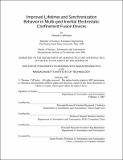| dc.contributor.advisor | Raymond Sedwick. | en_US |
| dc.contributor.author | McGuire, Thomas John, 1977- | en_US |
| dc.contributor.other | Massachusetts Institute of Technology. Dept. of Aeronautics and Astronautics. | en_US |
| dc.date.accessioned | 2007-08-29T19:06:20Z | |
| dc.date.available | 2007-08-29T19:06:20Z | |
| dc.date.issued | 2007 | en_US |
| dc.identifier.uri | http://hdl.handle.net/1721.1/38527 | |
| dc.description | Thesis (Ph. D.)--Massachusetts Institute of Technology, Dept. of Aeronautics and Astronautics, 2007. | en_US |
| dc.description | This electronic version was submitted by the student author. The certified thesis is available in the Institute Archives and Special Collections. | en_US |
| dc.description | "February 2007." | en_US |
| dc.description | Includes bibliographical references (p. 251-254). | en_US |
| dc.description.abstract | A high output power source is required for fast, manned exploration of the solar system, especially the outer planets. Travel times measured in months, not years, will require high power, lightweight nuclear systems. The mature nuclear concepts of solidcore fission and fusion Tokamaks do not satisfy the lightweight criteria due to massive radiators and magnets respectively. An attractive alternative is Inertial Electrostatic Confinement fusion. This extremely lightweight option has been studied extensively and to date has produced significant fusion rates of order 1010 reactions per second, but at low power gains, no higher than Q = 10-4. The major loss mechanisms for the state-of-the-art IEC are identified via a detailed reaction rate scaling analysis. The use of a single cathode grid causes short ion lifetimes and operation at high device pressure for simple ion generation both fundamentally limit the efficiency of these devices. Several improvements, including operation at much lower pressure with ion guns and the use of multiple cathode grids, are verified with particle-in-cell modeling to greatly improve the efficiency of IECs. These simulations show that the greatly increased confinement allows for the development of significant collective behavior in the recirculating ions. The plasma self-organizes from an initially uniform state into a synchronized, pulsing collection of ion bunches. | en_US |
| dc.description.abstract | (cont.) In simulations, these bunches are observed to be long-lived with lifetimes on the order of at least a tenth of a second, exceeding 20,000 passes. This represents a 3 order of magnitude improvement in confinement time and device efficiency. The synchronization of a bunch is due to the ion-ion interaction and kinematics of the well-confined IEC. The synchronization between beams is understood to arise from macroscale 'collisions' of bunches coupled with the kinematics of the device. Further, the collective effects limit the space charge buildup and higher densities result in violent ejection from the system. An IEC device which exploits the synchronization effect can achieve high efficiencies and gain, with fusion as the fastest collision timescale. Despite the potential of operation at break-even, the total power output is limited by the relatively low achievable core densities. The immediate application for this work is inexpensive neutron generators useful for medical, security, research, and industrial applications, but use much less power than a state-of-the-art IEC. The results of this thesis suggest two future research directions. First, neutralization of portions of the ion flow could allow greater densities and increase power output to levels required for space travel. Second, the idea of using kinematics coupled with ion-ion collisions to control thermalization may be applied to other plasma confinement concepts. | en_US |
| dc.description.statementofresponsibility | by Thomas J. McGuire. | en_US |
| dc.format.extent | 254 p. | en_US |
| dc.language.iso | eng | en_US |
| dc.publisher | Massachusetts Institute of Technology | en_US |
| dc.rights | M.I.T. theses are protected by copyright. They may be viewed from this source for any purpose, but reproduction or distribution in any format is prohibited without written permission. See provided URL for inquiries about permission. | en_US |
| dc.rights.uri | http://dspace.mit.edu/handle/1721.1/7582 | |
| dc.subject | Aeronautics and Astronautics. | en_US |
| dc.title | Improved lifetimes and synchronization behavior in multi-grid inertial electrostatic confinement fusion devices | en_US |
| dc.type | Thesis | en_US |
| dc.description.degree | Ph.D. | en_US |
| dc.contributor.department | Massachusetts Institute of Technology. Department of Aeronautics and Astronautics | |
| dc.identifier.oclc | 163114839 | en_US |
